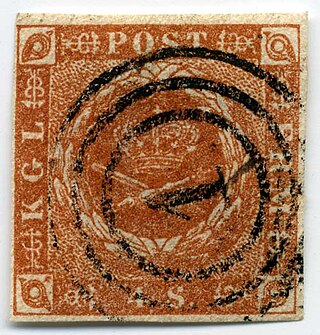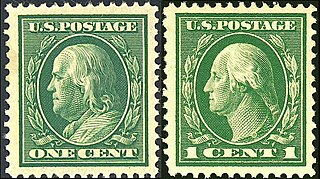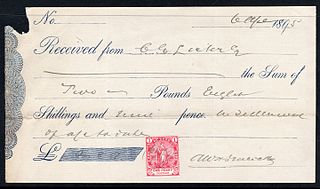This article includes a list of general references, but it lacks sufficient corresponding inline citations .(June 2013) |

This is a survey of the postage stamps and postal history of New South Wales, a former British colony now part of Australia.
This article includes a list of general references, but it lacks sufficient corresponding inline citations .(June 2013) |

This is a survey of the postage stamps and postal history of New South Wales, a former British colony now part of Australia.
New South Wales was the first part of Australia to be settled by Europeans, and the first to operate a postal service, which in 1803 was carrying letters between Sydney and Parramatta for a 2d charge. In 1809 a collecting office in Sydney was established to receive mail from passing ships, and in 1825 the postal service was expanded. Mail coach service began in 1830, and in 1835 a new Postage Act superseded the 1825 statute and set rates based on weight and distance travelled.
The postmaster of the time, James Raymond, was in communication with Rowland Hill in England and worked to encourage the prepayment of letters in NSW. In 1838, Raymond introduced envelopes embossed with the seal of the colony, and available for local mail for 1¼ pence each instead of the 2d charged letters paid for in cash. They are thus regarded as precursors of the Penny Black. However, the envelopes were not popular, and in 1841 Raymond was unable to develop official interest in postage stamps for the colony.

In 1842 regular mail service was carried by steamer between Melbourne and Sydney, and the first mail packet from Britain arrived in 1844. An act of 1848 reformed the postal system and authorised the use of stamps; the first stamps appeared on 1 January 1850. They were locally produced, and depicted a scene of Sydney and its harbour, thus becoming known as the "Sydney Views". The 1d, 2d, and 3d stamps were separately engraved, and then re-engraved and retouched over the next year, yielding dozens of varieties.
In 1851 the colony switched to a more conventional design, a profile of Queen Victoria wearing a laurel wreath, first in a somewhat crude rendition, then a better one in 1853. The colony also took the unusual step of using paper watermarked with the denomination, a practice that resulted in a number of mismatches between watermark and printed denomination that are rare and highly prized today.
In 1854 the colony issued 6d and 1/- stamps printed locally, from plates engraved by Perkins Bacon in England. These were large square stamps with the standard profile of Victoria wearing a diadem, framed with a hexagon and octagon respectively. The designs were reused for 5d and 8d in 1855.
In 1856 a Perkins Bacon design was also adopted for the lower values as well. The inking of all these was highly variable, and there are dozens of distinct colour varieties. The use of perforation began in 1860; unfortunately for collectors, the stamps were very closely spaced, the perforating process not well controlled, and it is unusual to find stamps from before 1899 where the perforation does not touch or cut into the design on one or more sides.

The first 5-shilling stamp was issued in 1861, and it was notable for being a round design resembling a medallion. In 1861, new designs were created by De La Rue and printed both in London and the colony.
In 1871 a watermark reading "NSW" surmounted by a crown began to replace the numerals, and in 1885 a need for high-values prompted the overprinting of 5/-, 10/-, and one-pound revenue stamps with "POSTAGE".

New South Wales celebrated its 100th anniversary in 1888 with an issue of what is widely considered to be the first commemorative stamps. The set of eight, each with a different design, were all inscribed "ONE HUNDRED YEARS". Among the designs were a view of Sydney, an emu, Captain Cook, a lyrebird, and a kangaroo. The 20/- value included portraits of both Arthur Phillip the first governor, and the then-governor Lord Carrington.
A 2½d stamp depicting an allegorical figure of Australia appeared in 1890, while ½d, 7½d, and 12½d values were produced in 1891 as surcharges on existing stamps.

In 1897 two early semi-postal stamps were issued, paying 1d and 2½d rates, but sold for 1/- and 2/6 respectively, the additional proceeds going to a Consumptives' Home. In the same year a set of three stamps marked Victoria's Diamond Jubilee.
The formation of the Commonwealth had no immediate effect on the NSW postal system. Although the new constitution granted the commonwealth power to run a national postal service, unification was not immediate. The systems gradually merged during the 1900s. In 1903 a 9d stamp in two colors (brown and blue) was inscribed "COMMONWEALTH" and mentioned the initials of each member along with its year of founding. In 1905 the stamps began to be printed on paper watermarked with a crown and the letter "A", with reprintings of existing designs occurring into 1910.
In 1913 the stamps of New South Wales were superseded by those of Australia. [1]
Most of the stamps of New South Wales are readily available today, but it is somewhat complex to collect; there are a dozen types of watermarks, multiple perforations, and numerous colour shades. While the Scott catalog distinguishes about 200 major types, it calls out many more minor varieties, and the Stanley Gibbons catalog totals some 400 distinct varieties.
Numeral cancellations on New South Wales postage stamps are also of interest to collectors. Ninety-six post offices had already been opened when the first postage stamps were issued on 1 January 1850. Numeral obliterators were allocated to these post offices to cancel stamps on outgoing mail. Sydney itself had no number and used dumb obliterators. The first allotment of numbers was based on the pattern of roads radiating outward from Sydney.
Numerals and obliterators continued to be allocated to opening post offices up to the beginning of 1904 with 2099 (Toolijooa) probably the last number assigned. The patterns of allocation provide a way of tracking the history of settlement of the state, although made complex by re-allocations as post offices closed or jurisdiction was transferred, as happened when Queensland became a separate colony.
Larger post offices also impressed a date-stamp on covers with the name of the originating office. This means that covers or stamps torn from covers or pairs of stamps can be used to tie numbers to mailing offices where official records are missing. Even so, as many as 300 New South Wales numbers are still untied.
There can be many variations of numeral cancellations depending on the type of obliterator used. The first obliterators allocated had horizontal bars. These were followed by "ray" types. The colour of the ink used might also vary. The Sydney obliterators also exist in many variations.
Most collectors of numerical cancellations ignore the stamp itself, which may appear upside-down or sideways in albums or stock cards.
New South Wales issued its own postal stationery until the Commonwealth of Australia stationery was made available in 1911. Envelopes were issued in 1838 for local use within Sydney, New South Wales and were used till 1857. Between 1870 and 1911 eleven different envelopes were produced and issued. Registration envelopes were first made available to the public in 1880 and a total of 14 different were produced. Newspaper wrappers were available from 1864, New South Wales being the second postal administration after the United States to issue newspaper wrappers. A total of 12 different wrappers are known. Letter cards were in use from 1894 and a total of 11 different letter cards were produced. Postcards were available from 1875 and, by the time the Australian Commonwealth postcards were introduced, New South Wales had produced a total of 34 different items. [2]

A postage stamp is a small piece of paper issued by a post office, postal administration, or other authorized vendors to customers who pay postage. Then the stamp is affixed to the face or address-side of any item of mail—an envelope or other postal cover —which they wish to send. The item is then processed by the postal system, where a postmark or cancellation mark—in modern usage indicating date and point of origin of mailing—is applied to the stamp and its left and right sides to prevent its reuse. Next the item is delivered to its addressee.

A cancellation is a postal marking applied on a postage stamp or postal stationery to deface the stamp and to prevent its reuse. Cancellations come in a huge variety of designs, shapes, sizes, and colors. Modern cancellations commonly include the date and post office location where the stamps were mailed, in addition to lines or bars designed to cover the stamp itself. The term "postmark" refers specifically to the part that contains the date and posting location, but the term is often used interchangeably with "cancellation" as it may serve that purpose. The portion of a cancellation that is designed to deface the stamp and does not contain writing is also called the "obliteration" or killer. Some stamps are issued pre-cancelled with a printed or stamped cancellation and do not need to have a cancellation added. Cancellations can affect the value of stamps to collectors, positively or negatively. Cancellations of some countries have been extensively studied by philatelists, and many stamp collectors and postal history collectors collect cancellations in addition to the stamps themselves.
East Africa and Uganda Protectorates was the name used by the combined postal service of the British protectorates, British East Africa and Uganda, between 1 April 1903 and 22 July 1920.

This is an overview of the postage stamps and postal history of Denmark.
This is a list of philatelic topics.

This is an overview of the postage stamps and postal history of Australia.
This is a survey of the postage stamps and postal history of British East Africa.

The British Central Africa Protectorate existed in the area of present-day Malawi between 1891 and 1907.

The postage stamps of Ireland are issued by the postal operator of the independent Irish state. Ireland was part of the United Kingdom of Great Britain and Ireland when the world's first postage stamps were issued in 1840. These stamps, and all subsequent British issues, were used throughout Ireland until the new Irish Government assumed power in 1922. Beginning on 17 February 1922, existing British stamps were overprinted with Irish text to provide some definitives until separate Irish issues became available within the new Irish Free State. Following the overprints, a regular series of definitive stamps was produced by the new Department of Posts and Telegraphs, using domestic designs. These definitives were issued on 6 December 1922, the day that the Irish Free State officially came into existence; the first was a 2d stamp, depicting a map of Ireland. Since then new images, and additional values as needed, have produced nine definitive series of different designs.

The postal history of Malta began in the early modern period, when pre-adhesive mail was delivered to foreign destinations by privately owned ships for a fee. The earliest known letter from Malta, sent during the rule of the Order of St John, is dated 1532. The first formal postal service on the islands was established by the Order in 1708, with the post office being located at the Casa del Commun Tesoro in Valletta. The first postal markings on mail appeared later on in the 18th century.

The postal history of Turkey and its predecessor state, the Ottoman Empire, dates to the 18th century when foreign countries maintained courier services through their consular offices in the Empire. Although delayed in the development of its own postal service, in 1863 the Ottoman Empire became the second independent country in Asia to issue adhesive postage stamps, and in 1875, it became a founding member of the General Postal Union, soon to become the Universal Postal Union. The Ottoman Empire became the Republic of Turkey in 1923, and in the following years, its postal service became more modernized and efficient and its postage stamps expertly designed and manufactured.

This is a survey of postage stamps and postal history of the German colonies and part of the postage stamps and postal history of Germany, as well as those of the individual countries and territories concerned.

This is a survey of the postage stamps and postal history of Cape of Good Hope.
This is a survey of the postage stamps and postal history of British Bechuanaland.

Victoria, a state of Australia and until 1901 a British colony, was still under the control of New South Wales when its first post office was opened in Melbourne in April 1837. Post offices opened at Geelong and Portland soon after, and by 1850 there were forty-five post offices.

The Washington–Franklin Issues are a series of definitive U.S. Postage stamps depicting George Washington and Benjamin Franklin, issued by the U.S. Post Office between 1908 and 1922. The distinctive feature of this issue is that it employs only two engraved heads set in ovals—Washington and Franklin in full profile—and replicates one or another of these portraits on every stamp denomination in the series. This is a significant departure from previous definitive issues, which had featured pantheons of famous Americans, with each portrait-image confined to a single denomination. At the same time, this break with the recent past represented a return to origins. Washington and Franklin, after all, had appeared on the first two American stamps, issued in 1847, and during the next fifteen years, each of the eight stamp denominations available featured either Washington or Franklin.

This is a survey of the postage stamps and postal history of Queensland, a former British Crown Colony that is now part of Australia.

Coded postal obliterators are a type of postmarks that had an obliterator encoded with a number, letter or letters, or a combination of these, to identify the post office of origin. They were introduced in the United Kingdom of Great Britain and Ireland in 1843, three years after the first stamp was issued. They became common throughout the nineteenth century but very few remained in use until the twentieth century.

Cape of Good Hope issued revenue stamps from 1864 to 1961. There were a number of different stamps for several taxes.

Hong Kong issued revenue stamps from 1867 to the 1990s, both when it was a British colony as well as when it was under Japanese occupation.